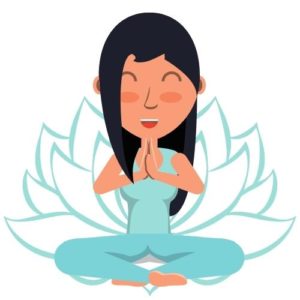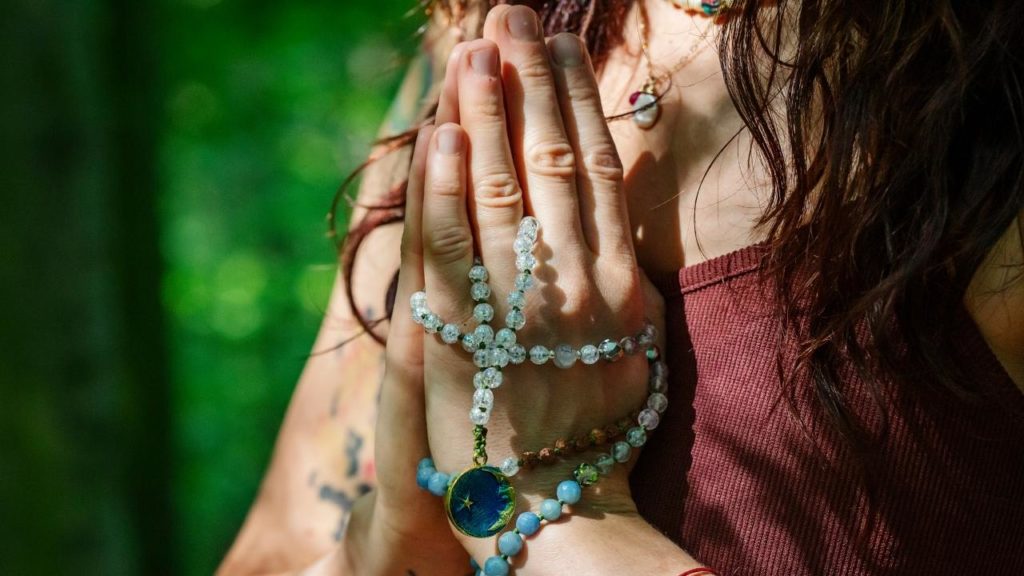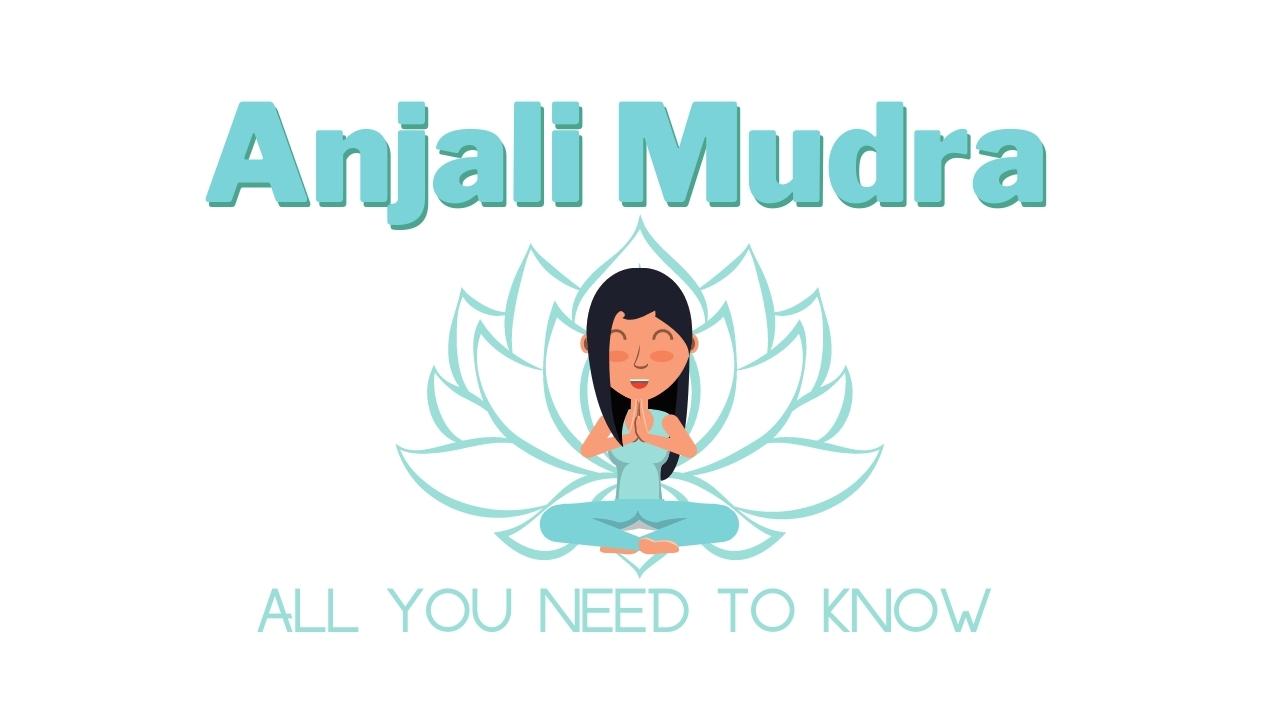Ever wondered what that little “praying hand gesture” is that people do at the beginning or the end of a yoga class, followed by a “Namaste“? It’s called Anjali Mudra, and it’s actually a lot more than just a way to wrap up a yoga session. In this blog post, we’ll take a closer look at what Anjali Mudra is, how to do it, and what benefits it can bring to your practice.

Table of Contents
- What is a Mudra?
- What is Anjali Mudra?
- What are the Benefits of Anjali Mudra?
- How to Do Anjali Mudra
- Is Namaste a Mudra?
- How do you pronounce Anjali Mudra?
- What does Anjali mean?
- Some Great Ways to Practice Anjali Mudra by Yourself
- Summary
What is a Mudra?
Yoga mudras are symbolic hand gestures that are often used in Yoga as well as in tantric and meditative practices. The Yoga Sutras of Patanjali describe 84 classic Yoga mudras.
Yoga mudras are said to affect the flow of energy in the body and can be used to help focus the mind during meditation.
Some common Yoga mudras include Gyan Mudra (the gesture of knowledge), Surya Mudra (the gesture of the sun), and Chandra Mudra (the gesture of the moon).
Yoga mudras can be performed with one or both hands, and each hand can be in a different mudra. Mudras can also be combined with pranayama (breath control) and asana (Yoga postures) to create a complete Yoga practice.
What is Anjali Mudra?
Anjali Mudra is a hand gesture that is often used in yoga and meditation practices. It is made by placing the palms of the hands together in front of the chest in a prayer-like position, with the fingers pointing up. The word “Anjali” comes from the Sanskrit word meaning “offering,” while “Mudra” means “gesture” or “seal.” Thus, Anjali Mudra can be interpreted as an offering of the heart.
Anjali Mudra is not only used at the opening or closing of a class led in a Yoga Shala but also during some Yoga asanas like:
- Tadasana (Mountain Pose)
- During Surya Namaskar A and B (Sun Salutations)
- Vrkasana (Tree Pose)
- Parivrtta Utkatasana (Revolved Chair Pose)
Anjali Mudra is also used during chanting or meditation, helping the practitioner to stay focused. Summarized, Anjali Mudra might be used in any practice that requires heightened concentration as means of grounding and centering oneself.
What are the Benefits of Anjali Mudra?
There are many benefits associated with practicing Anjali Mudra. This hand gesture helps to create a feeling of gentleness, love, and compassion. It also encourages the release of negative emotions such as anger and frustration.
Additionally, the mudra has been shown to help reduce stress and anxiety levels, lower blood pressure, and slow down breathing rates. As such, this mudra can be very calming and grounding for both the mind and body. In summary, we can say that:
- It helps to focus during meditation or difficult Yoga poses.
- Creates a feeling of gentleness, love, and compassion.
- Can reduce anxiety by heightening your focus.
How to Do Anjali Mudra

Anjali Mudra is a relatively simple mudra. Simply bring the palms of your hands together in front of your chest in a prayer position, with the fingers pointing upward. You can place your hands wherever is comfortable for you; some people like to have their hands close to their heart center, while others prefer to hold their hands out further away from their bodies. There is no wrong way to do Anjali Mudra, so long as both palms touch each other and all fingers point upward.
According to the great Yoga Master Krishnamacharya, one should not put the palms flat together and bend the knuckles at the base of the fingers a little bit. This creates space between the fingers and palms of both hands, creating the resemblance of a flower yet to open, a symbolization of a heart that is opening. Summarized, that is:
- Put your hands together in a prayer-like position in front of your heart.
- Leave a little space between your palms.
- Bend the knuckles at the base of the fingers slightly.
Is Namaste a Mudra?
Namaste is not technically a mudra but is instead a gesture of respect that is often done in conjunction with Anjali Mudra.
Namaste is traditionally done by placing the palms of the hands together in front of the heart center, with the fingers pointing up, and then bowing the head. Thus, Namaste can be interpreted as an offering of respect, gratitude, or honor.
How do you pronounce Anjali Mudra?
Anjali Mudra is pronounced: “Ahn-jah-lee-moo-dra.”
The pronunciation is not very difficult, but it is important to correct the intonation.
- The first syllable, “An,” should be pronounced with a long “a” sound, as in the word “father.”
- The second syllable, “ja,” should be pronounced with a short “a” sound, as in the word “cat.”
- The third syllable, “li,” should be pronounced with a long “I” sound, as in the word “tree.”
- The fourth syllable, “mu,” should be pronounced with a short “u” sound, as in the word “mud.”
- The fifth and final syllable, “dra,” should be pronounced with a long “a” sound, as in the word “drama.”
So, to recap, the correct pronunciation is: “Ahn-jah-lee-moo-dra.”
What does Anjali mean?
Anjali is a Sanskrit word that holds the meaning of “divine offering.” It is often used as a mudra, or gesture of respect, in yoga and meditation practices. Anjali is also the name of a popular Indian actress.
She has starred in many Bollywood films, such as Kuch Kuch Hota Hai and Kabhi Khushi Kabhie Gham. Anjali is a beautiful name with many positive connotations. It will surely bring good luck and fortune to anyone who bears it.
Some Great Ways to Practice Anjali Mudra by Yourself
If you want to implement Anjali Mudra into your Yoga practice or even try it out for the first time, there is nothing holding you back.
You can use the mudra at the beginning of your Yoga practice as a means to set your Sankalpa (intention). That way, you make sure to take some time aside to really focus on what you want to achieve through your practice.
You can also use it during or at the beginning of your meditation. For this, we recommend sitting in a comfortable position like Sukhasana (easy pose) and putting your hands together in front of your heart in Anjali Mudra. While some people find it difficult to hold the mudra for extended periods of time, others feel an increase in focus, especially those among us who have a hard time emptying the mind.
If you focus on your hand position and your breath, Anjali Mudra can be a great help in your meditation practice. You can use Anjali Mudra to connect with your higher power or whatever you believe in. Simply put your hands together and close your eyes, picturing the energy of your chosen deity entering through your palms and filling up your entire body.
Start by doing Anjali Mudra for 1 minute and gradually increase the time as you feel comfortable.
- You can use it at beginning of yoga practice to set Sankalpa (intention).
- You can use it during or at the beginning of meditation practice.
- Focus on hand position and breath.
- You can use it to connect with higher power and energies.
- Start by doing it for 1 minute and gradually increase the time as comfortable.
Summary
If you’re looking for a simple way to bring more peace and compassion into your life, this beautiful hand gesture can be done anywhere, anytime, and requires no special equipment or training. Give it a try today!
- Anjali Mudra is a gesture of respect, gratitude, or honor and can also be interpreted as an offering of Namaste.
- Anjali Mudra is pronounced: “Ahn-jah-lee-moo-dra.”
- Anjali Mudra can be done anywhere, anytime, and requires no special equipment or training.
- You might be surprised at the peace and compassion it can bring into your life.
